CORE Physical Therapy In Omaha Explains…
By Dr. Mark Rathjen PT DPT CSCS
CORE Physical Therapy Co-owner
17660 Wright St. 9/10
Omaha NE
402-933-4027
Ankle sprains are very common in sports. In fact, there are roughly 25000 per year. A vast majority of these individuals are athletes. Ankle sprains that involve ankle damage of ligament damage, 6-8 are imperative for normal tissue healing, and 12 weeks post incidence may be indicated for return of strength, balance and propriocetion.
Proprioception is the body’s ability to communicate from the conscious and subconscious brain positional awareness to the body. Its a form of coordination, but a more complicated one. The 3 systems of balance are vision, vestibular, and proprioception.
Extensive 6 week training programs for balance and preventions are shown in the literature to be a vital component to recovery. Bracing and taping can also have and additive effect for prevention for up to 6 months post injury.
“Eight weeks after training, statistically significant (p< 0.017) improvements were found in dorsiflexion ROM and most functional performance measures for both balance and PNF groups. Eight weeks after training, significant (p< 0.017) improvements in the frontal plane balance test and pain were observed for the balance group.”
Research is extensive in this area of study, and Our Blogs here at CORE Physical Therapy and Sports Performance are littered with research on that very topic.
At CORE Physical Therapy in Omaha, We specialize in the treatment of athletes. We have worked with athletes for a combined 30 years. CORE was established in 2015 by Dr. Mark and Dr. Claire Rathjen is family owned and operated.
We are proud to serve the greater Omaha metro area.
For More information, Please feel free to contact us http://coreomaha.com/contact/
Please feel free to follow us at https://www.facebook.com/COREomaha/
To get started http://coreomaha.com/getting-started/
For more Blog information http://coreomaha.com/blog/
Youtube Account linked below.
https://www.youtube.com/channel/UCVg8OSN5h-i1n_ykw1Gvahg?view_as=subscriber
. 2018;31(3):437-446.
doi: 10.3233/BMR-170836.
Effects of two proprioceptive training programs on ankle range of motion, pain, functional and balance performance in individuals with ankle sprain
- PMID: 28946541
- DOI: 10.3233/BMR-170836
Abstract
Background: Following ankle sprain, residual symptoms are often apparent, and proprioceptive training is a treatment approach. Evidence, however, is limited and the optimal program has to be identified.
Objective: To investigate the effects of two post-acute supervised proprioceptive training programs in individuals with ankle sprain.
Methods: Participants were recruited from a physiotherapy center for ankle sprain rehabilitation. In a pre-post treatment, blinded-assessor design, 22 individuals were randomly allocated to a balance or a proprioceptive neuromuscular facilitation (PNF) group. Both groups received 10 rehabilitation sessions, within a six-week period. Dorsiflexion range of motion (ROM), pain, functional and balance performance were assessed at baseline, at the end of training and eight weeks after training.
Results: Follow-up data were provided for 20 individuals. Eight weeks after training, statistically significant (p< 0.017) improvements were found in dorsiflexion ROM and most functional performance measures for both balance and PNF groups. Eight weeks after training, significant (p< 0.017) improvements in the frontal plane balance test and pain were observed for the balance group.
Conclusions: Balance and PNF programs are recommended in clinical practice for improving ankle ROM and functional performance in individuals with sprain. Balance programs are also recommended for pain relief.
Keywords: Ankle sprain; dynamic balance; function; pain; proprioceptive training; range of motion.

